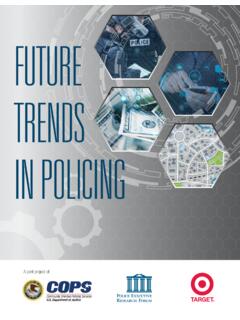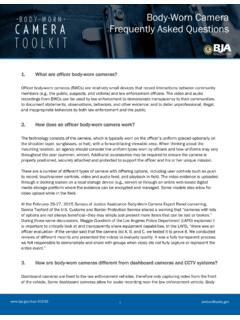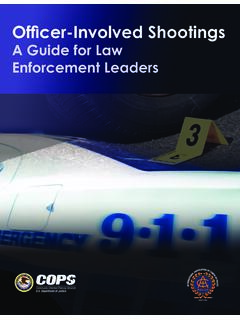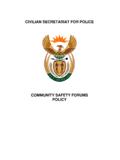Transcription of Understanding Community Policing
1 Department of JusticeOffice of Justice ProgramsBureau of Justice AssistanceBureau of Justice AssistanceUnderstandingCommunity PolicingA Framework for ActionD E P A R T M E N T O F J U S T I C E O F F I C E O F J U S T I C E P R O G R A M S B J A N I J O J J D P B J S O V C MONOGRAPHaaaAugust 1994 NCJ 148457 UnderstandingCommunity PolicingA Framework for ActionBureau of Justice AssistanceMONOGRAPHiiBureau of Justice AssistanceThis document was prepared by the Community PolicingConsortium, supported by grant number 93 DD CX K005, awardedby the Bureau of Justice Assistance, Department of opinions, findings, and conclusions or recommendationsexpressed in this document are those of the authors and do notnecessarily represent the official position or policies of the of of Justice AssistanceResponse Center633 Indiana Avenue NW.
2 , Washington, DC 20531800 421 6770 The Bureau of Justice Assistance is a component of the Office of Justice Programs, whichalso includes the Bureau of Justice Statistics, the National Institute of Justice, the Office ofJuvenile Justice and Delinquency Prevention, and the Office for Victims of Bureau of Justice Assistance wishes to thank Stephen J. Gaffigan,Director of Operations, Community Policing Consortium for supervisingand coordinating the preparation of this document with the ConsortiumManagement Team. BJA also acknowledges the members of the ExecutiveBoard and Advisory Board, who provided a wealth of expertise and infor-mation essential to the content of the Management TeamStephen J. GaffiganDirector of OperationsCommunity Policing ConsortiumRay GalvinProject DirectorInternational Association ofChiefs of PoliceJohn R.
3 DoyleProject DirectorNational Sheriffs AssociationJohn StedmanActing Associate Director ofResearchPolice Executive Research ForumBill MatthewsDeputy Director forAdministrationPolice FoundationLillian T. DoteOperations CoordinatorCommunity Policing ConsortiumAdvisory BoardDr. Lee ColwellUniversity of Arkansas atLittle Rock2801 South University Rock, AR 72204 Executive BoardRichard WardDirector, DiscretionaryGrant Programs DivisionBureau of Justice AssistanceDan RosenblattExecutive DirectorInternational Association ofChiefs of PoliceCharles Bud MeeksExecutive DirectorNational Sheriffs AssociationChuck WexlerExecutive DirectorPolice Executive Research ForumHubert WilliamsPresidentPolice FoundationMember of the NationalOrganization of Black LawEnforcement ExecutivesMargaret HeislerProgram Manager, LawEnforcement BranchBureau of Justice AssistanceStephen J.
4 GaffiganDirector of OperationsCommunity Policing ConsortiumivBureau of Justice AssistanceChief Sylvester DaughtryChief of PoliceGreensboro Police Department300 West Washington Box 3136 Greensboro, NC 27402 3136 Member of the NationalOrganization of Black LawEnforcement ExecutivesDr. Jack GreeneDirector, Center for Public PolicyTemple UniversityGladfetter Hall, 10th Floor12th St. and Berks MallPhiladelphia, PA 19122 Commissioner Gil KerlikowskeBuffalo Police Department74 Franklin , NY 14202Mr. Bob LambRegional Director, CommunityRelations Department of Justice915 2d Ave., Room 1898 Seattle, WA 98174 Member of the NationalOrganization of Black LawEnforcement ExecutivesThe Honorable Caroline Long BanksCity CouncilwomanAtlanta City Council55 Trinity , GA 30335 The Honorable Edwin J.
5 RousseauCommissionerBoard of Commissioners of theCounty of AllenCity-County Bldg., Room 2001 East Main Wayne, IN 46802 1893Mr. Clifford L. SargeonChairmanBoard of Directors of theAd Hoc Group Against Crime3330 Troost City, MO 64109 The Honorable Kurt SchmokeMayor of the City of Baltimore250 City Hall100 North Holliday , MD 21202 Sheriff Patrick J. Sullivan, County Sheriff s Office5686 South Court , CO 80120 1200Ms. Edna ThomasSoul Box 3278 Newark, NJ 07103Dr. Hans TochDistinguished ProfessorState University of New Yorkat Albany135 Western , NY 12222 Superintendent Matt L. RodriguezChicago Police Department1121 South State , IL 60605 2398 Past members of the Consortium Man-agement Team include Jerry Needle,Director, Programs and Research Divi-sion, International Association ofChiefs of Police; John E.
6 Eck, Execu-tive Director, Crime Control Institute;and Peter Scharf, Director, Technol-ogy and Technical Assistance Divi-sion, Police Foundation. Programresearch and document preparationwas completed by William D. Falcon;vMonographCraig Fraser, Associate Director, Man-agement Services, Police ExecutiveResearch Forum; Phyllis MacDonald,Command Executive, ManagementSupport and Development Command,New York City Transit Police Depart-ment; Kevin Morison, Assistant Coor-dinator Specialist, Research andDevelopment Division, Chicago Po-lice Department; Timothy , Police Lieutenant and Di-rector, Houston Police Academy; andMary Ann Wycoff, Director, ResearchDivision, Police Foundation. Editorialsupport was provided by GeorgeZimmar, President, YES, Inc. LindaEdwards, Administrative Assistant,Technical Assistance Division, PoliceFoundation, did much of the finalfact-finding Policing is, in essence, a collaboration between the police andthe Community that identifies and solves Community problems.
7 With thepolice no longer the sole guardians of law and order, all members of thecommunity become active allies in the effort to enhance the safety andquality of neighborhoods. Community Policing has far-reaching implica-tions. The expanded outlook on crime control and prevention, the new em-phasis on making Community members active participants in the process ofproblem solving, and the patrol officers pivotal role in Community policingrequire profound changes within the police organization. The neighbor-hood patrol officer, backed by the police organization, helps communitymembers mobilize support and resources to solve problems and enhancetheir quality of life. Community members voice their concerns, contributeadvice, and take action to address these concerns.
8 Creating a constructivepartnership will require the energy, creativity, Understanding , and patienceof all communities is essential if we are to deter crime and createmore vital neighborhoods. In some communities, it will take time to breakdown barriers of apathy and mistrust so that meaningful partnerships canbe forged. Trust is the value that underlies and links the components ofcommunity partnership and problem solving. A foundation of trust willallow police to form close relationships with the Community that willproduce solid achievements. Without trust between police and citizens,effective Policing is monograph is a product of the Community Policing Consortium,which is made up of the International Association of Chiefs of Police,the National Sheriffs Association, the Police Executive Research Forum, andthe Police Foundation.
9 Reflecting the Consortium s perspective, the docu-ment describes the historical evolution of Community Policing and its po-tential for the future, and it will provide the basis for the Consortium s workwith demonstration sites and law enforcement organizations as they imple-ment Community Policing . The knowledge gained from this sitework willbe reflected in future Consortium publications. Some examples of thesepublications are nExpansion of Understanding Community Policing :A Framework for ActionThis preliminary study will be expanded in the future as the Con-sortium continues its work with police departments as they imple-ment Community Policing . The goal of this work is to share practicalinformation with the law enforcement profession throughout the countryPrefaceviiiBureau of Justice Assistancethat will help them plan and implement Community Policing based uponthe experiences of other Series of MonographsThe Consortium is planning to publish a series of individual monographsthat will address issues relating to the implementation of communitypolicing.
10 The topics for these monographs will target critical implemen-tation issues such as strategic planning, internal and external assessmentmeasures, and methodologies for conducting successful internal andexternal needs StudiesThe Consortium will identify applications of Community Policing thatimprove local crime control and prevention initiatives and will documentthese experiences for publication and dissemination to other dynamic and ongoing process will allow for the immediate exchangeof practical experiences for the benefit of other communities. This processwill also identify the successes, failures, and frustrations that reflect thereality of implementing Community Consortium looks forward to working collaboratively with law enforce-ment organizations throughout the country as they explore strategies foreffectively implementing Community Policing .














